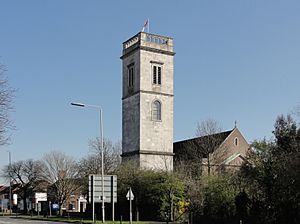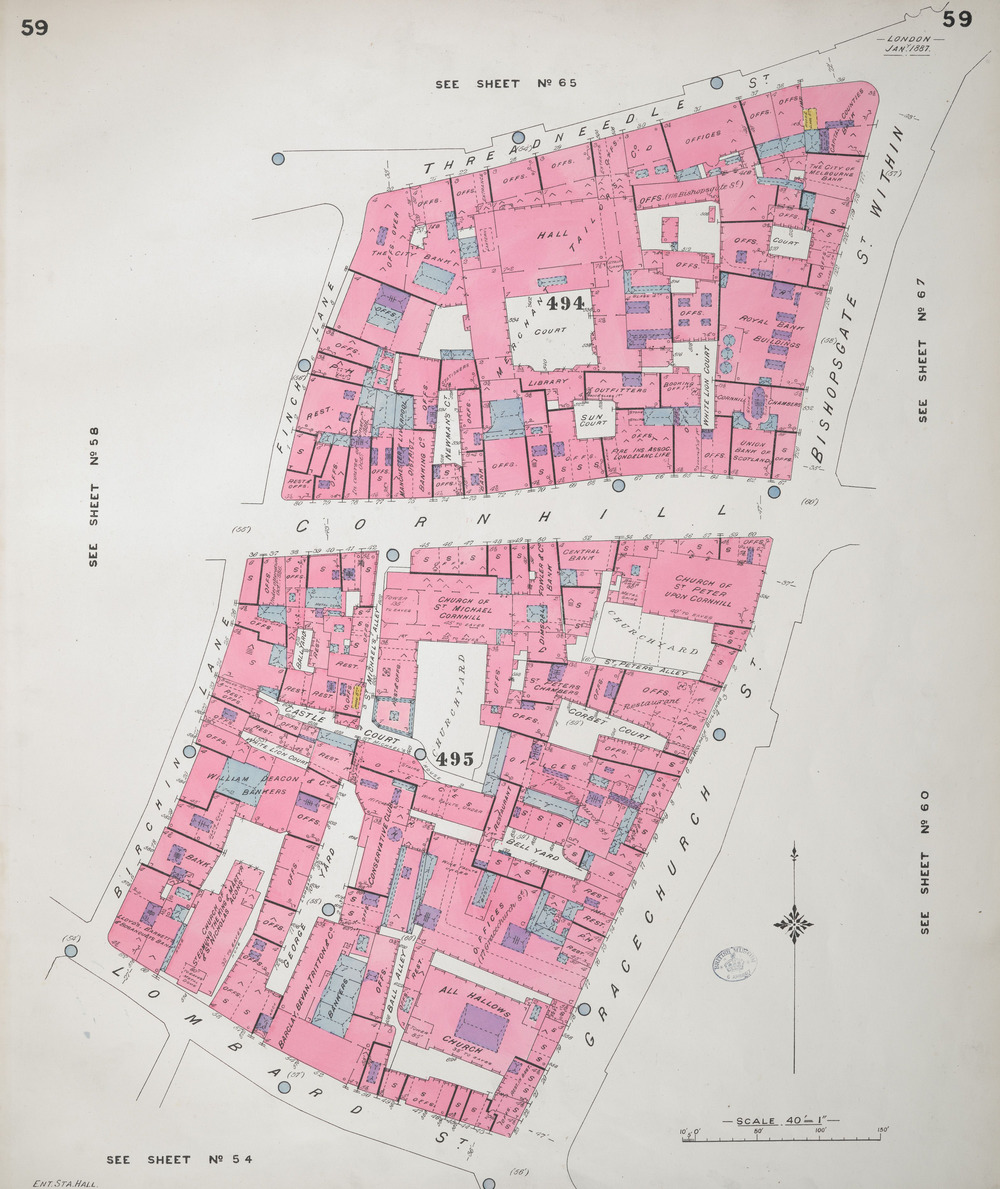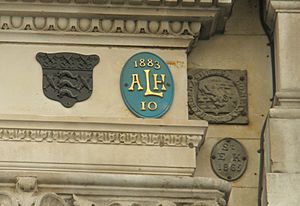All Hallows Lombard Street facts for kids
Quick facts for kids All Hallows Lombard Street or All Hallows Gracechurch Street |
|
|---|---|

All Hallows from Ball Alley in the 1820s
|
|
| Location | One of four churches between Lombard Street, Cornhill and Gracechurch Street, London |
| Country | England |
| Denomination | Anglican |
| Previous denomination | Roman Catholic |
| History | |
| Founded | before 1054 |
| Architecture | |
| Years built | before 1065; rebuilt c.1500; rebuilt c.1694 |
| Closed | 1937 |
| Demolished | 1937 |
| Administration | |
| Parish | All Hallows, Lombard Street |
| Diocese | London |
All Hallows Lombard Street was an old church in the City of London. It was also known as Gracechurch Street. The church was tucked away behind other buildings on Lombard Street and Gracechurch Street. Its west and south sides faced an alley called Ball Alley. This church was very old, dating back to medieval times. It had to be rebuilt after the terrible Great Fire of London. In 1937, the church was taken down. However, its tower was rebuilt in Twickenham as part of a new church called All Hallows. Many of its original bells and inside decorations were also moved there.
Contents
A Look at the Old Church
Early Beginnings
All Hallows church was first mentioned in records in 1054. This was when a London citizen named Brihtmerus gave the right to choose its priest to the Canterbury Cathedral. A famous historian named John Stow wrote about London in the 1600s. He called it "All Hallows Grasse Church." This was because a grass market used to be in that area. The street was much wider back then.
Rebuilding in Medieval Times
The church was rebuilt around the early 1500s. The south side of the church was finished in 1516. The Pewterer's Company helped pay for a north side and other parts. A bell tower was completed in 1544. For this, stones from a closed monastery, St John of Jerusalem, were used. The church also bought bells from this monastery. Sadly, a person who was going to pay for them died. So, the tower ended up with only one bell. After many monasteries were closed down in England, the right to choose the priest for All Hallows went to the Dean and Chapter of Canterbury.
Rebuilding After the Great Fire
The Great Fire of London in 1666 caused a lot of damage to All Hallows. At first, the people tried to fix it up. They even put straw and lime on the walls to stop them from falling apart. A bell was hung in the shaky steeple as late as 1679. But in the end, it was too damaged to repair. So, a new church was built. It was designed by the famous architect Sir Christopher Wren's team. The new church was finished in 1694. It cost about £8,058, which was a lot of money back then!
The "Invisible Church"
The outside of the new church was quite plain. In the 1830s, a writer named George Godwin said the church was so hidden by other buildings that it was hard to find. He even called it "the invisible church." The stone tower was on the west side of the south wall. Today, you can see a faithful copy of this tower in Twickenham. The tower has three levels. The bottom level has a small entrance with fancy columns. The middle level has round windows. The top level has square openings for the bells. The tower is about 85 feet (26 meters) tall.
Inside the Church
The church was about 84 feet (26 meters) long and 52 feet (16 meters) wide. Inside, it was one big open space without separate aisles. There was a balcony at the west end, held up by a single column. The ceiling was curved at the sides. There were five windows on the north side and four on the south. The front of the church only got light from two small windows on the sides. In 1880, a skylight was added to the ceiling for more light.
The walls were covered with oak wood up to about 9 feet (2.7 meters) high. Above the north door, there was a wooden statue of Death. Above the south door, there was a similar statue of Time. These statues had fancy carvings that looked like a curtain. Many people thought it was a real curtain! The church also had special seats for important people. There was a place in the entrance area with shelves for bread given to the poor. The altar area had a beautiful oak screen with a carved pelican and seven candle holders.
An organ built by Renatus Harris was put in the church in 1695. It was replaced in 1902. During the Napoleonic Wars, the space above the roof was used to store ammunition by a group of volunteers.
John Wesley's Visit
A church record from December 28, 1789, says that John Wesley, a very famous preacher, gave a sermon there. He once remembered a time when he was about to preach but forgot his sermon notes. He told the church helper about it.
The helper replied, "What, cannot you trust God for a sermon?" After hearing this, he went into the pulpit and preached very well. From that day on, he never took notes with him again.
The Church Moves On

In 1879, ten bells from another church were hung at All Hallows. But fewer and fewer people were living in the City of London. After the First World War, it was decided that the church would be taken down. Many people were against this idea. In 1937, the church was found to be unsafe and was demolished. Sir Christopher Wren's tower, the entrance, and many of the church's furnishings were moved. They were used to build the new All Hallows Church in Twickenham. The small area the church served was joined with another church nearby. Today, the old church site is part of a large modern building with shops.
Ball Alley, which connected the church to Lombard Street, is now part of this new building. In its last years, the church was hard to get to, with only narrow paths. A special mark showing the church's old boundary can still be seen on Lombard Street.
All Hallows Today
The area that All Hallows church once served is now part of a bigger church area. This combined area includes several other churches. It is part of the Church of England's Diocese of London.
Images for kids







